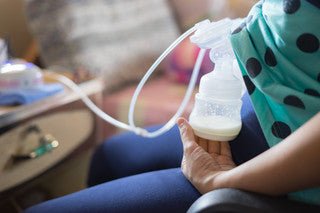How Do I Know What Size Flange To Use With My Breast Pump?

One of the most common questions I get from my clients concerns the proper use of their breast pump. While there are many things that new moms must consider when choosing and using their breast pump, one of the most important items is the pump flange and its size.

This infographic offers a great method for figuring out what flange size you need. Read on to find out more about flanges and why size matters!
The breast pump flange is the part of the pump that goes directly on the breast over the nipple. The nipple is pulled into the cone of the flange, stimulating the nipple and causing the breast milk to flow from the breast. Being sure to choose the appropriate size flange is supremely important for optimal milk output during pumping.
The flange should fit comfortably around the nipple while the pump is off. Once the pump is turned on, the nipple should move freely within the flange cone - without rubbing the sides of the cone. If the nipple is touching or rubbing against the flange, it can cause discomfort, which will negatively impact milk output. This may also impede feeding from the breast when mom and baby are together due to soreness and discomfort.
To this same point, the flange should also not be too large. If there is a great deal of space around the nipple when the flange is placed, this can cause too much of the areola to enter the flange while the pump is on, which will also cause discomfort, and again, negatively impact milk output. An improperly fitting flange can also lead to blocked milk ducts. Blocked milk ducts are very painful and can lead to an infection of the duct called mastitis.
Most breast pumps come with two different sizes of flange. Depending on the brand, they typically range from 24 mm to 27 mm. If neither size appears to fit correctly, the pump manufacturer should have alternative sizes available for purchase. Check with your health insurance carrier on whether or not they will cover the cost of the appropriate flange size. Many insurance carriers will now provide a breast pump at no cost to breastfeeding mothers, and some will also cover replacement parts.
Another good resource to consider is the pump manufacturer itself. Many times they will be willing to work with new moms to be sure that the pump works as effectively as possible, and they may provide alternative flange sizes free of charge.
Keep in mind that pump flanges do have to be replaced occasionally. Most manufacturers recommend replacing flanges every 6 to 9 months to maintain optimal performance and proper pump hygiene. Additionally, it is not recommended that flanges be sterilized in steam sterilizers or placed in the dishwasher. Many times these sterilizing options heat the plastic to too high of a temperature too fast, causing the parts to become distorted. If there is any change in the shape of the pump flange, there is a possibility that it will not fit correctly, causing discomfort and a decrease in milk output.
There are so many things to take into consideration when buying a breast pump, from how often it will be used, to how portable it can be. Once the prime pump is picked out, the next most important thing to determine is appropriate flange fit. Even the strongest, most efficient pump will be limited in performance by a poorly fitted flange.
If you are struggling to find the right flange size, or you just want to have peace of mind that your current setup is the perfect fit, schedule a Virtual Flange Sizing appointment with us!








